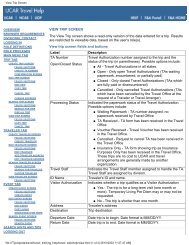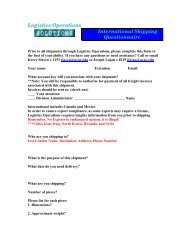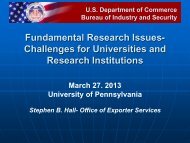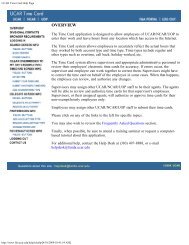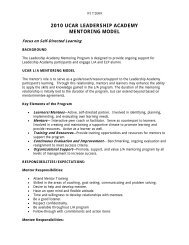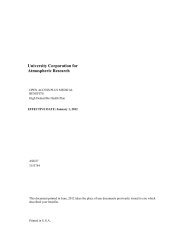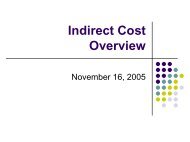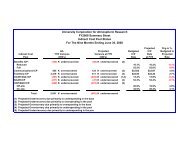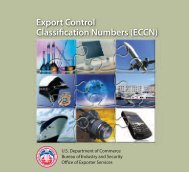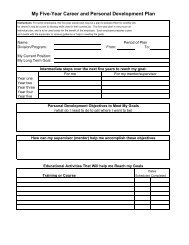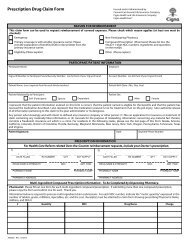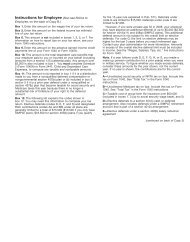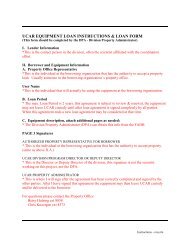Towards a Metrics Implementation Plan - UCAR Finance ...
Towards a Metrics Implementation Plan - UCAR Finance ...
Towards a Metrics Implementation Plan - UCAR Finance ...
Create successful ePaper yourself
Turn your PDF publications into a flip-book with our unique Google optimized e-Paper software.
1 IntroductionThis document’s objective is to offer the <strong>UCAR</strong> President’s Council suggestions for developinga <strong>Metrics</strong> <strong>Implementation</strong> <strong>Plan</strong> (MIP) tied to the <strong>UCAR</strong> strategic plan. This document is theoutcome of a <strong>UCAR</strong> 2006 Leadership Academy Action Learning Team project. The ActionLearning Team (subsequently referred to as “the Team”) chose a topic suggested by JackFellows, vice president of Corporate Affairs and the director of the <strong>UCAR</strong> Office of Programs.Fellows’ initial charge to the Team statesWhat metrics (process, input, output, outcome, and impact) should weuse to monitor progress toward our mission and goals? The NationalAcademy released a report recently entitled “The Appropriate Use of<strong>Metrics</strong> for the Climate Change Science Program” that explored metrics inour world. <strong>UCAR</strong> also developed a “survey” of metrics recently. Alongwith the NA report, it might be quite useful to take that survey the nextstep and develop a metrics implementation plan that could be part of theproposal (i.e., how we expect to measure progress toward our goals).Fellows elaborated on this initial charge in a meeting with the Team at the outset of this project.In that meeting, Fellows relayed that Cliff Jacobs (NSF Atmospheric Sciences Division sectionhead) would like to see the <strong>UCAR</strong> metrics reflect NSF’s metrics. Further, Jacobs wanted the<strong>UCAR</strong> metrics to be tied to the upcoming <strong>UCAR</strong>*2020 Strategic <strong>Plan</strong>.In 2002, an NSF-appointed review panel noted that “<strong>UCAR</strong>/NCAR/UOP should develop arobust set of metrics (beyond citation analyses) that characterize the quality, effectiveness andefficiency or both science programs and service functions…. A comprehensive set ofperformance metrics would help <strong>UCAR</strong> and NSF with strategic planning and aid comparisonswith other organizations” (“Measuring the Productivity, Quality, and Impact of <strong>UCAR</strong>Programs,” <strong>UCAR</strong> 2005).In addition to appreciative interviews 1 , we referred to three key documents for information.Section 2.1 describes these documents in more detail.(1) “<strong>UCAR</strong>*2020: A Strategic Outlook for the University Corporation for AtmosphericResearch” (<strong>UCAR</strong> 2006 - Draft), subsequently referred to as the “<strong>UCAR</strong> Strategic <strong>Plan</strong>.”This document describes the goals of the organization. The metrics implementation planis intended to measure progress toward these goals.(2) National Research Council’s “Thinking Strategically: The Appropriate Use of <strong>Metrics</strong>for the Climate Change Science Program.” Committee on <strong>Metrics</strong> for Global ChangeResearch, Climate Research Committee, National Academy of Sciences, subsequentlycalled the “NRC document.” This document gives an organization-independent view ofmetrics and offers suggestions for metrics implementation methods.1 “Appreciative [interview] questions are written as affirmative probes into an organization’s positive core, in thetopic areas selected. They are written to generate stories, to enrich the images and inner dialogue within theorganization, and to bring the positive core more fully into focus.” http://www.positivechange.org/appreciativeinquiry.htmlaccessed June 7, 2006.1




